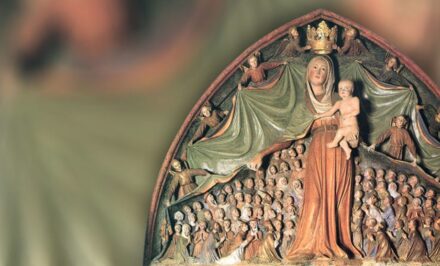 Fr. Javier Arteaga. Many pilgrims, when they arrive at the Schoenstatt Shrine, ask if the Virgin ever appeared there as it has happened at other holy places like Lourdes or Fatima for example. No, in Schoenstatt there was never an apparition of the Mother of God. She manifested herself, and she clearly manifests herself in this small Shrine, bestowing to all the pilgrims abundant graces from God. Thus, that which Father Kentenich said on October 18, 1914, is fulfilled: “All who come here to pray should experience the glory of Mary.” There, where the Virgin Mary is, life comes forth…hope and peace radiate. And, like every good mother, She acts in favor of all her children…concerning herself in a particular way for those who suffer most…for those most in need…for those who are the weakest.
Fr. Javier Arteaga. Many pilgrims, when they arrive at the Schoenstatt Shrine, ask if the Virgin ever appeared there as it has happened at other holy places like Lourdes or Fatima for example. No, in Schoenstatt there was never an apparition of the Mother of God. She manifested herself, and she clearly manifests herself in this small Shrine, bestowing to all the pilgrims abundant graces from God. Thus, that which Father Kentenich said on October 18, 1914, is fulfilled: “All who come here to pray should experience the glory of Mary.” There, where the Virgin Mary is, life comes forth…hope and peace radiate. And, like every good mother, She acts in favor of all her children…concerning herself in a particular way for those who suffer most…for those most in need…for those who are the weakest.
A testimony of living faith about Mary’s action in the Shrine
Some years ago, a woman being troubled by a great family problem told me that she went to the Shrine of Our Lady of Schoenstatt. In her desperation, she could only find some peace by going to the Shrine and being with her “little Mother.” Little by little, her grief lessened. She found new perspectives to her situation and thus was able to face decisions. The problem did not change, but she had changed when facing the problem. She had strength to live. Her story was more than mere words. It was a testimony of living faith– about Mary’s action in the Shrine.
There are many and diverse Marian Shrines in the world and manifold are the graces, which Mary grants there. Father Kentenich would say “Mary wants to offer us here (in the Shrine) a spiritual home, a homeland, a native land.” (Stuttgart, 1940)
Father Kentenich, with a prophetic perception of the epoch’s problems, detected that we were facing a radical change in the world, and that man is at the center of the problems. He perceived the enormous uprooted existence and existing orphan-hood, as well as a growing process of mass-mindedness and man’s “disquietude.” He saw the dangerous supplanting of cultural and religious values by a practical atheism. Father Kentenich said that these new times required a new type of personality, which would give new responses to these problems, and he affirmed that this renewal from the soul of man can only be realized by the Virgin Mary, Mother and Educator of the new man in Christ.
The Covenant of Love
This was the personal experience of Father Kentenich on October 18, 1914. That day, in the old chapel, he and a group of youths sealed a Covenant of Love with the Blessed Virgin. There he told them: “Would it then not be possible for our little sodality chapel to likewise become for us the Tabor on which the glory of Mary would be revealed? Undoubtedly, we could not accomplish a greater apostolic deed nor leave our successors a more precious legacy than to urge our Lady and Queen to erect her throne here in a special way, to distribute her treasures, and to work miracles of grace.”
A few months earlier, the Great War in Europe had commenced, and if the propaganda had fostered a warlike euphoria in the hearts of those youths, their families and the majority of the population, there was also uncertainty and sorrow. What could be done for those youths who would soon be called to the front of the battle? How could they be helped to remain strong in their faith and strong in their ideals of sanctity amidst the war?
Through that Covenant of Love, which the youths sealed with the Blessed Virgin, through that surrender of childlike love – confident and heroic – Mary took possession of the little chapel and it became her Shrine. For the youths, the Shrine was a home and a school of renewal and sanctity. Father Kentenich said: “It is not about a place of grace in the common meaning of the word, but that from the beginning, it was about a place of grace for souls, to explain it thus; not principally for the healing of illnesses nor things of that style, but of special graces for the renewal of souls and for the renewal of the world. In summary: Our heavenly Mother chose the little chapel as a special place of grace to begin or fulfill from here a part of the renewal of the world and make of us her instruments in that endeavor.”
Fruitfulness of sanctity and of social renewal in Christ
Dear brothers and sisters, thanks be to God, our reality is not the war, but Argentina is marked by great problems that are our challenge today: respect for human life, social peace, equitable development, bread and work in each home, education, health… Today Mary also asks us to bear fruits of personal sanctity and of social renewal in Christ. It is about our Covenant lived faithfully and creatively…that it matures and bears fruit in daily life… that it becomes gestures, words and attitudes like dialogue, encounter, harmony, respect, forgiveness and reconciliation, the strength to grow and love. For such a profound change, the Shrine continues being, today as yesterday, the privileged place where Mary educates and creates a new culture, the culture of the Covenant.
(Covenant letter, February 2012)
Translation: Carlos Cantú, Schoenstatt Family Federation, La Feria, Texas USA 02222012













